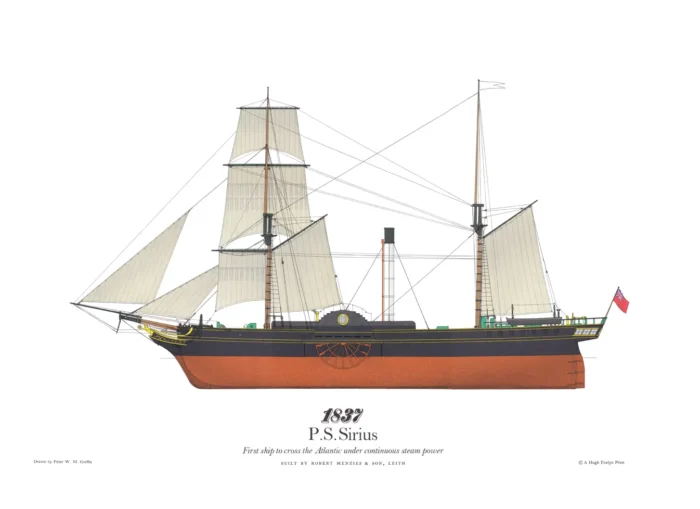S.S. Sirius, 1837
£20.00
S.S. Sirius: Saint George Steam Packet Co, Cork, Ireland (scroll down for a more detailed Description)
Print published 1968 by © Hugh Evelyn Limited; drawn by Peter W.M. Griffin.
Print size: c. 48 x 40 cm [19” x 14”] (size may vary slightly from printers’ cut 60 years ago)
Printed on heavy white cardstock c. 135 g/sm2.
Print is LARGE size – shipping is the same for 1 to 10 prints (based on largest print size in your order) – see Shipping & Returns
In stock
Description
Owner: Saint George Steam Packet Co, Cork, Ireland;
Builder: Robert Menzies & Sons, Leith, Scotland;
In Service: 1837;
703 GRTons; Leingth: 178 ft (54 m) Beam: 26 ft (8 m);
Sirius was a side-wheel wooden-hulled steamship built in 1837 by Robert Menzies & Son, Leith, for the London-Cork route operated by the Saint George Steam Packet Company. The next year, she opened transatlantic steam passenger service when she was chartered for two voyages by the British and American Steam Navigation Company. By arriving in New York a day ahead of the Great Western, she is usually listed as the first holder of the Blue Riband, although the term was not used until decades later. In late 1840 Sirius was sent to Gibson’s Dry Dock at Hull for new boilers but remained there over two years as the dry dock had to be specially lengthened. In the face of financial difficulties, the St George company was refinanced in 1844 and took the style City of Cork Steam Ship Company, with which Sirius continued her regular employment on the Irish Sea. Sirius was wrecked in 1847. On 16 January, on a voyage to Cork from Glasgow via Dublin with cargo and passengers, she struck rocks in dense fog in Ballycotton Bay, Ireland. Despite being refloated, she was found to be leaking badly and, in steaming for the shore, was wrecked on Smith’s Rocks, half a mile from Ballycotton. The only lifeboat launched was heavily overloaded; swamped by heavy seas, the twelve passengers and two crew were drowned. Most of the 91 on board were rescued by rope passed to the shore, though twenty lives in all were lost.
Additional information
| Weight | 0.0235 kg |
|---|---|
| Dimensions | 48 × 34.5 cm |





